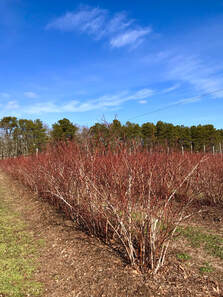Farm Journal- February

It might be a trick of the light but we have noticed a subtle change in the color out in the field. Although we expect the blueberry plants to remain in full dormancy until March, every year can be a bit different. The soft amber glow is present here and there among the crimson branches- a sure sign of spring to our eyes. After all, the world's most famous groundhog, Punxsutawney Phil, has predicted an early spring and we second that motion. February 2nd is also Candlemas Day, a cross-quarter day between the winter solstice and spring equinox, and was thus considered the beginning of spring in early agrarian societies.
A little science is in order- the end of dormancy arrives after the plants have accumulated about 800 hours of "chill time" which generally runs 3-4 months, entered into last November. The plants do not need extreme cold nor do they need snow just enough accumulated hours at 38-43 degrees and we have had those.
February is a short month, although 2020 is a leap year so there is one extra day. There can be snow. This month's full moon is called the Snow Moon for good reason. We have had such a mild winter and since we are not as fond of snow as we once were, that is fine with us. Spring is at least on the horizon, quite noticeable beyond the rows with the lengthening day and with dawn's spring warblers.
A little science is in order- the end of dormancy arrives after the plants have accumulated about 800 hours of "chill time" which generally runs 3-4 months, entered into last November. The plants do not need extreme cold nor do they need snow just enough accumulated hours at 38-43 degrees and we have had those.
February is a short month, although 2020 is a leap year so there is one extra day. There can be snow. This month's full moon is called the Snow Moon for good reason. We have had such a mild winter and since we are not as fond of snow as we once were, that is fine with us. Spring is at least on the horizon, quite noticeable beyond the rows with the lengthening day and with dawn's spring warblers.